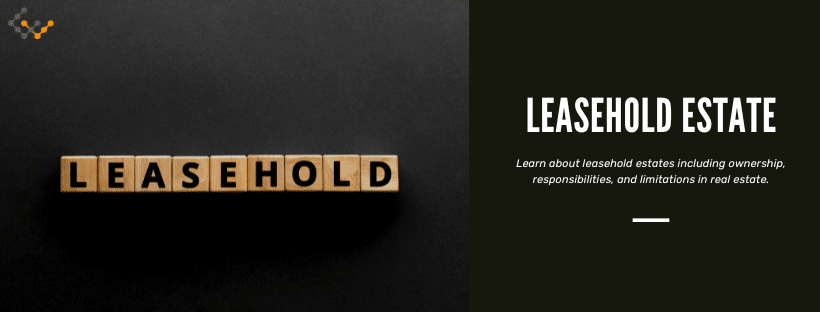Understanding Leasehold Estate

Leasehold estate or leasehold property is a term often heard in relation to accounting. It refers to an asset of some type that is being leased. In commercial real estate, a leasehold is likely to be a space or building. This term is not commonly used today, but it is still a factor investors should consider when involved in commercial real estate transactions.
What Is a Leasehold Estate?
What is a leasehold estate definition? In a leasehold estate, the landlord is also known as the lessor. The tenant is called a lessee. The lessor allows the lessee to occupy the property, generally for a specific length of time.
In this situation, the lessor maintains the ownership of the property. On the greater scope, just about all commercial leases are a type of leasehold.
This is different from a freehold estate. In that situation, the property owner will occupy the property, or the landlord will occupy the property. In a freehold estate, the property’s ownership and use of the property are not set on a specific timeline. Rather, the property can be sold or transferred to another party at any time.
Answer a few questions and get custom mortgage quotes. We'll match you with offers from our network of 650+ lenders.
In a leasehold estate, by contrast, the arrangement is locked in for a specific amount of time. The lessee of the property is able to occupy that property for the time listed in the agreement.
In a leasehold estate agreement, the owner does not maintain the ability to do whatever they want with the property. Though they own the property, they leave it to someone else for a set amount of time. At that time, the owner does not have the right to make changes to the property. The owner cannot tear down the structure or otherwise adjust the property while the lessee has rights to it.
Types of Leasehold Estate
There are several types of leasehold estates.
- Periodic tenancy: In this type of leasehold agreement, the lessee will occupy the property from a specific start date. However, they do not have an agreed end date. This is commonly known as a month-to-month lease. Instead of having an end date, the lease continues unless the tenant or the property owner alerts the other to the ending of the agreement.
- Estate for years: This particular type of property has a lease that has a specifically defined start date and a defined end date. The amount of time is defined but could be as short as several months up to several years, whatever the tenant and landlord agree upon.
- Estate at will: In this situation, sometimes called a tenancy at will, there is no end date or lease period assigned. That means that the tenant has the ability to occupy the building or property on an ongoing basis as long as the property owner or landlord allows them to do so. The tenant or landlord simply gives notice when the agreement is set to end. Yet, in this situation, there is often no lease in place. Keep in mind that not all states allow for this type of agreement as being legally binding.
- Estate at sufferance: In some situations, the tenant decides to remain at the property beyond the expiration of the lease. This is called estate at sufferance and sometimes is known as a tenancy at sufferance. In some cases, the landlord or property owner will need to take legal steps to have the party removed.
What is a Leasehold Commercial Property?
A leasehold of commercial property applies in the same way as it would residential property. The property owner sets up a leasehold agreement with the tenants who will occupy the space for a specific length of time, as defined in the lease agreement. In this case, those tenants are typically commercial businesses of some type.
How Leasehold Estate Works in Commercial Real Estate
In commercial real estate, a leasehold estate allows the investor to acquire an interest in the property. They have the right to use that property, occupy it, and possess it, but they do not have ownership of the underlying real estate the property sits on.
The benefit of this is that the investor gains access to the property and can use it to operate their business, but they do not have to pay a large upfront payment to purchase the property outright.
From the vantage of the property owner, the owner has the benefit of leasing the property owner for rental payments to earn an income. Yet, they maintain ownership of the property over the long term.
What Is Considered a Leasehold Estate?
A leasehold estate is easily defined as a property in which one party owns it, and another party uses it. In nearly all legally binding scenarios, there will be an agreement that outlines a start and/or end date for the arrangement to remain in place.
Commercial Leasehold Estate Example
An investor purchases the commercial property, for example, a warehouse space. They then find and lease that space to a tenant who will be able to use the property to meet their needs, such as maintaining their product inventory. The tenant has the right to access that space and use it under the terms of the agreement, and the property owner does not have the legal right to transfer or access that property. The lease continues based on the terms of the agreement.
Leasehold Estate vs Freehold Estate: What’s the Difference?
The terms are often confused but they are very different situations:
- Leasehold estate: The property owner leases the property to someone else who will occupy it.
- Freehold estate: The property owner occupies the property.
Generally, the leasehold agreement is in place for a set amount of time, such as several months. In a freehold estate, the property owner can do anything they want, under law, with the property. However, if they lease it, and it becomes a leasehold estate, the owner no longer maintains that type of ability.
Benefits and Risks of Buying a Leasehold Property
The benefits of buying leasehold property:
- As an investor, it allows the investor to receive ongoing income from the rental payments made by the tenant. They own the real estate long-term.
- For the tenant, this means opening a business or getting off the ground without having to pay out of pocket for the purchase of the property.
There are a few drawbacks of a leasehold interest:
- It can be harder to obtain a loan with leasehold-interest real estate. That means that, in some cases, it may be hard to finance the leasehold property to purchase as an investor.
- The property owner also must agree to vacate the property – they are no longer allowed to remain on the leasehold property.
Wrapping Things Up
Leasehold land is a very common arrangement. Having a leasehold interest as an investor and property owner can make sense for those who wish to own and maintain that ownership of the real estate but who do not have or want to use the property directly themselves.
They can maintain the leasehold interest and get a return on their investment for rental income produced. Though it can be harder to obtain loans, there are still numerous opportunities for many investors to make full use of them.

